
|
What is
a Guitar Set-Up?
By
Geoff Luttrell, SF Guitarworks
© 2005 All rights reserved
Every guitar needs to play in tune all over the neck, and to have
a string height that allows for comfortable playability. Most guitars,
both new and old, are lacking one or both of these traits. This is
due to a lack of time at the factory, weather conditions, poor construction
or age. A set-up is the adjustment procedure used to bring an instrument
to it's full potential, addressing both intonation and playability
issues. There may be things that a set-up will not address, such
as bad frets, improper bridge location, fingerboard/neck imperfections,
incorrect nut or lack of truss-rod operation. The set-up will get
the instrument to the point that it plays as well as it can in it's
current state, and any other issues may be dealt with at that time.
I'm not sure how other shops do set-ups, but I do know it is mostly
by feel. I tried this for a time, but decided that this procedure
needed a more systematic approach. The set-up is the cornerstone
of the repair world, and I want to make sure that the set-ups I perform
are always an improvement. To allow me to reach this goal, I developed
a set-up checklist. Sounds pretty simple, but I think I am the only
shop in the Bay that uses one. It is a list of steps, from initial
measurements as the guitar arrives, through the steps required to
correct the playability/intonation, with the final action measurements
taken as the last step. Here is a set-up on a Telecaster that will
outline the procedure and the benefits of the SF Guitarworks set-up
system.
First things first- After discussing the instrument with the player,
we have a good idea about what needs to happen to the instrument.
The first step is to take the current action measurements. we measure
the action at the 12th fret on the bass and treble side, the neck
relief, the string gauge and the bridge radius. Now we have a starting
point and will absolutely know the results of the set-up.
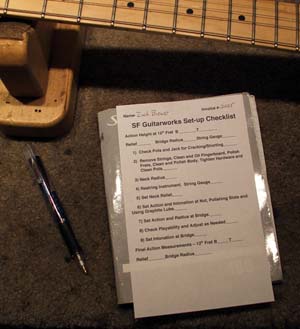
The next step is to check the pots and jack for cracking
or shorts. The strings are then removed and all of the hardware is
tightened. The instrument is thoroughly cleaned, including polishing
the frets, and the neck radius is checked. We will need this info
during the final stages of the set-up.
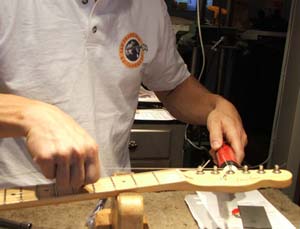
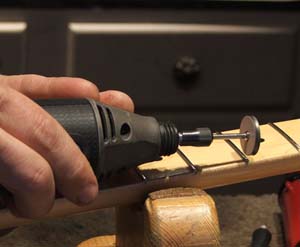
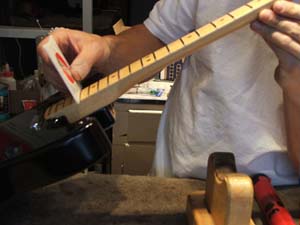
The instrument is then re-strung and the truss-rod
is adjusted to flatten the neck. Using graduated nut files, the action
is set at the nut. This is done with the neck flat so that any light
buzz at the first fret will be eliminated when the neck has some
relief. The height of the strings at the nut is critical. If the
strings are too high, or the slots are cut incorrectly, the first
few frets will play sharp. The width is also very important as the
slots must be tight enough to hold the string securely, but not so
tight that the string binds, causing tuning issues. We polish the
bottom of the nut slots with 600 grit sandpaper and use Guitar Grease
to minimize friction in the slots.


The next step is to set the action and radius at the
bridge. You will generally have made some request about the action,
so we will know if it needs to be higher, lower or the same. The
action height is set to allow for a minimum of buzzing and full string
bends. Then the bridge radius is set to correspond with the radius
of the neck. Sometimes it can be a bit flatter to keep the action
down in the middle of the fingerboard but generally, the radius at
the bridge should match the radius of the neck. We use a radius gauge
to measure the radii of the neck and strings, making the procedure
very accurate.

At this point it is time for some playing. Every fret
will be checked for buzzing, and the action will be adjusted accordingly.
When the playability is right on, the last adjustment to be made
is the intonation at the bridge. We use a Peterson Strobe tuner for
absolute accuracy.
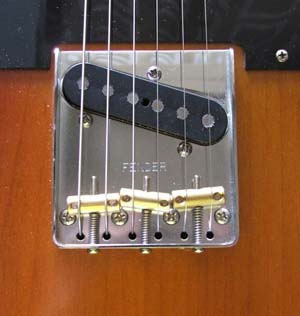
After the adjustments are complete, we measure the
final action measurements and keep a copy of the checklist on file.
Over time, the instrument may feel as though the action is changing.
If this is the case it is simple for me to pull your checklist, re-measure
your action and determine what is going on. This is one of the areas
where a set-up at SF Guitarworks stands out from the rest. You can
drop in and within minutes we can tell you what is happening with
your instrument. No guesswork, no mistakes. Thanks so much for reading!
I look forward to working for you.
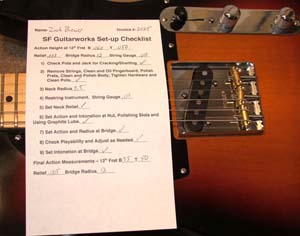
About
the Author: Geoff Luttrell is the proprietor of San Francisco Guitarworks
located at 323 Potrero Avenue in San Francisco. His extensive list
of clients include Camper Van Beethoven, Autumdivers and the Bobbleheads
to name a few. For more information, check out his web site at www.sfguitarworks.com.
|
|
 |